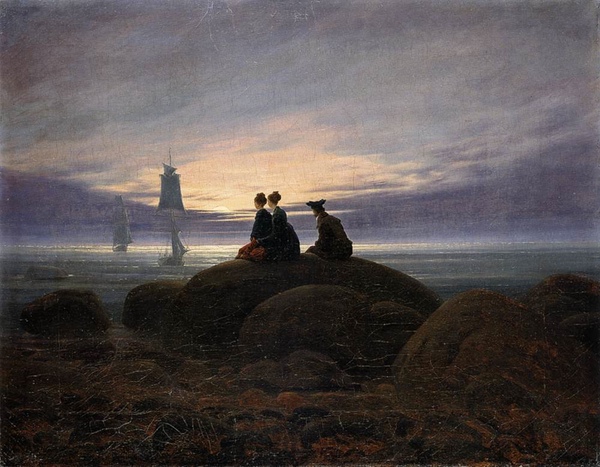
Füllest wieder Busch und Tal
Still mit Nebelglanz,
Lösest endlich auch einmal
Meine Seele ganz;
Breitest über mein Gefild
Lindernd deinen Blick,
Wie des Freundes Auge mild
Über mein Geschick.
Jeden Nachklang fühlt mein Herz
Froh- und trüber Zeit,
Wandle zwischen Freud’ und Schmerz
In der Einsamkeit.
Fließe, fließe, lieber Fluß!
Nimmer werd’ ich froh;
So verrauschte Scherz und Kuß
Und die Treue so.
Ich besaß es doch einmal,
was so köstlich ist!
Daß man doch zu seiner Qual
Nimmer es vergißt!
Rausche, Fluß, das Tal entlang,
Ohne Rast und Ruh,
Rausche, flüstre meinem Sang
Melodien zu!
Wenn du in der Winternacht
Wütend überschwillst
Oder um die Frühlingspracht
Junger Knospen quillst.
Selig, wer sich vor der Welt
Ohne Haß verschließt,
Einen Freund am Busen hält
Und mit dem genießt,
Was, von Menschen nicht gewußt
Oder nicht bedacht,
Durch das Labyrinth der Brust
Wandelt in der Nacht.
Once more you fill bush and valley
With your misty light,
At last also you bring
Rest to me
With calm you spread your brilliant gaze
Over the fields around me
Like my loved one watching my fate
With his gentle eyes
Every echo fills my heart
With memories of glad and sad times,
I pass between the happiness and pain
In loneliness.
Flow on, flow on my beloved river,
Happiness will not return to me
Thus they passed from me
Laughter, kisses and fidelity.
Though once I held
what is so precious,
What one to his torment
Will never forget.
Rumble, o river, along the valley,
Without rest or silence,
Rumble and whisper melodies
For my song.
When on winter nights you
Rage and spill your banks,
Or when you surge around
The springtime glory of young buds
Blessed are we who withdraw
From the world without hate
Holding a friend to the breast,
And with him enjoy
That which is not known to man
Or not contemplated
Wandering in the night
Through the labyrinth of the heart.
—Johann Wolfgang Goethe, An den Mond (1778) in Sämtliche Werke vol. 2.1, pp. 34-36 (K. Richter ed. 1987)(S.H. transl.)
Goethe’s poem To the Moon is an introspective love offering born of tragic events. On January 17, 1778, Christel von Lassberg, the young daughter of an army officer, had committed suicide by throwing herself in the icy waters of the Ilm river. She acted out of despair over unrequited love. The incident occurred but a short distance from Goethe’s garden cottage in Weimar, and it apparently brought him great pain. He took the young woman’s death as the subject for an exceptionally moving poem he composed for his paramour, Charlotte von Stein. The poem is written in the voice of the departed Christel. She addresses herself simultaneously to the river and to her beloved, the two fuse in the cold embrace of death. It is a typical early Romantic work inspired by the voice of nature, in which tragedy and love blend with acceptance of fate and of unfathomable mysteries.
Schubert realized the musical potential of the work very early, and had a long engagement with it. There are two settings of this poem. The first, DV 259, is charming and quite simple. It’s plain that Schubert was not satisfied with this effort, which fails to probe the dark and pathos-laden side of Goethe’s poem. But just where the first effort fell short, the second, composed the same year, succeeds brilliantly. Fischer-Dieskau, who must be reckoned the definitive interpreter of this work, says that it assumes a mood “between happiness and pain” for its coloration. The notes flow like the lethal waters of the river Ilm, they are filled with sadness and longing and surrounded by a note of the demonic. The effect is complex, brimming with loss and heartbreak. But the image of the river is essential both to the music and the poem. It strikes the note of continuity, it rages and floods, but ultimately comes to a peaceful merger with the sea. The river has become a metaphor for a life of passion, torment, betrayal. Death is presented as rest and reconciliation.
Listen to Franz Schubert’s setting of the poem, DV 296 (1815), in a performance by Dietrich Fischer-Dieskau, accompanied by Gerald Moore on the piano:


